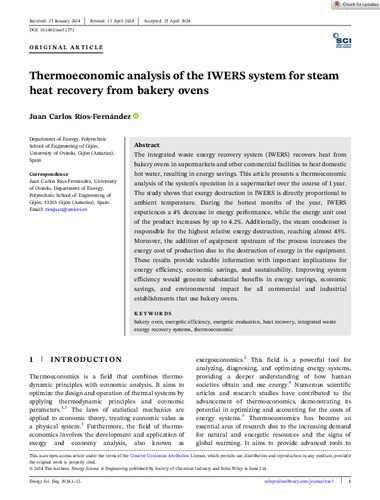Thermoeconomic analysis of the IWERS system for steam heat recovery from bakery ovens
Autor(es) y otros:
Palabra(s) clave:
Bakery oven
Exergetic efficiency
Exergetic evaluation
Heat recovery
Fecha de publicación:
Versión del editor:
Citación:
Descripción física:
Resumen:
The integrated waste energy recovery system (IWERS) recovers heat frombakery ovens in supermarkets and other commercial facilities to heat domestichot water, resulting in energy savings. This article presents a thermoeconomicanalysis of the system's operation in a supermarket over the course of 1 year.The study shows that exergy destruction in IWERS is directly proportional toambient temperature. During the hottest months of the year, IWERSexperiences a 4% decrease in exergy performance, while the exergy unit costof the product increases by up to 4.2%. Additionally, the steam condenser isresponsible for the highest relative exergy destruction, reaching almost 45%.Moreover, the addition of equipment upstream of the process increases theexergy cost of production due to the destruction of exergy in the equipment.These results provide valuable information with important implications forenergy efficiency, economic savings, and sustainability. Improving systemefficiency would generate substantial benefits in energy savings, economicsavings, and environmental impact for all commercial and industrialestablishments that use bakery ovens.
The integrated waste energy recovery system (IWERS) recovers heat frombakery ovens in supermarkets and other commercial facilities to heat domestichot water, resulting in energy savings. This article presents a thermoeconomicanalysis of the system's operation in a supermarket over the course of 1 year.The study shows that exergy destruction in IWERS is directly proportional toambient temperature. During the hottest months of the year, IWERSexperiences a 4% decrease in exergy performance, while the exergy unit costof the product increases by up to 4.2%. Additionally, the steam condenser isresponsible for the highest relative exergy destruction, reaching almost 45%.Moreover, the addition of equipment upstream of the process increases theexergy cost of production due to the destruction of exergy in the equipment.These results provide valuable information with important implications forenergy efficiency, economic savings, and sustainability. Improving systemefficiency would generate substantial benefits in energy savings, economicsavings, and environmental impact for all commercial and industrialestablishments that use bakery ovens.
ISSN:
DOI:
Ficheros en el ítem





